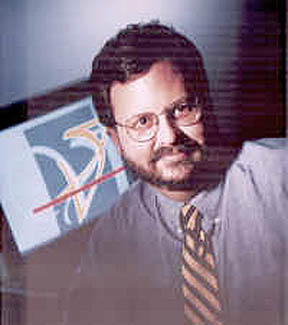The physical landscape of a typical business is changing. Some employees may now find themselves surrounded by family pets rather than cubical half-walls. Working for a business, yet out of the office, is the cresting wave in workplace trends.
In fact, 50 percent of employees in many companies arent located in the same office, or even city, as their managers. How do they communicate and collaborate? Typically, they rely on obvious technologies like the telephone and Internet. But the time has come to move beyond voice conferences and e-mail.
A company called Collaboration Architects constructs task-specific offices that bring geographically distributed teams together in cyberspace.
Collaboration Architects designs, constructs and implements online work environments that help people and organizations collaborate via the Web.
Dr. Bill Bruck, co-founder of Collaboration Architects, calls himself a Technology Sensei, because he uses principle from the martial arts to help companies make that technological change to a more virtual office. Bruck has written ten books on information technology, like Microsoft© Office, WordPerfect© Suite, PerfectOffice©, and GroupWise©. Hes also a psychologist and professor of psychology.
Bruck recently talked about why using the Web to collaborate with work groups is imperative in the new Information Age.
Q: Isnt using e-mail enough to collaborate virtually?
Bruck: Not really. You write an e-mail. You send it to 10 people. You get eight different responses. Now what do you do? Do you send eight different replies? Do you copy each reply to all 10 people? And if someone replies to your reply, should they copy it to everyone on the list? Its enough to give anyone a raging headache. A well-designed virtual office eliminates the frustrating e-mail trail by giving everyone a single location to make comments and respond to them. Its a nearly foolproof way to ensure that no one gets left out of the loop. Also, it documents every word thats exchanged. When you need to look back and confirm something, youll find the entire conversation recorded in one place, rather than having to open six months worth of e-mails.
A virtual workplace creates a living archive of documents. Memos, progress reports, schedules, budgets, press releases…all documents pertinent to your project can be archived in your online environment. Obviously, every team member benefits from having access to such materials. If someone misses an important meeting, he or she can go to the archive and review the notes. Successive drafts of documents can be posted so that the history of the project may be easily reconstructed. Decisions are recorded for posterity.
Q:Is sounds like this virtual work environment can be a more democratic way of collaborating.
Bruck: It does give everyone an equal voice. Synchronous describes a one-hour meeting. Asynchronous refers to what happens between that meeting and next meeting. Lets say a company holds a brainstorming meeting. We all know the ideas that are put on the table come from those people that are the quickest and the loudest. But suppose the company recorded these ideas in an asynchronous online environment and told everyone they had a week to review them and add others? Quieter folks, or those that prefer to mull things over, or those that just had a bad breakfast that morning would be much more inclined to post their ideas. In this way, a virtual workplace is a great equalizer.
Q: Some business resources are tight due to the economic downturn. Will going virtual help a companies financial health?
Bruck: Perhaps the biggest and most compelling reason to establish an online work environment is simply this: Its nothing less than an inevitability for corporations destined to survive and thrive in the Information Age.
Todays business leaders have a simple choice: They can quickly learn how to use online collaboration technology or they can bury their heads in the sand. Those who choose to learn increase their chances of staying competitive. For those who dont, its just a matter of time before they are out of the game altogether. And in todays world we are talking about months, not years, to experience competitive degeneration.
Q: What does the future look like for business collaboration?
Bruck: The electronic workplace is the workplace of the future. Fifty years from now well be holding long-distance meetings in front of life-size video screens just as a matter of course. But it has to begin somewhere, and that somewhere is finding better, more efficient ways to share information. The corporation that learns how to compete globally – and manage the attendant wealth of information effectively – will ultimately come out on top.
Q: In a nutshell, what does Collaboration Architects do?
Bruck: We create online work environments that allow people and organizations to collaborate via the Web. We are architects because we believe that the creation and implementation of successful online workplaces require the same level of quality thinking and artful employment of the right technologies as do the creation of physical workspaces. But whats just as important is that our solutions take into account the corporate culture – the reality – of each of our clients. Every organization has its own capacity to accommodate change, and we respect that. We make sure the solution we recommend is right for that client.
Q: Why would an organization need a virtual workplace?
Bruck: Well, there is no one-size-fits-all answer, as every company is different and has its own unique needs. But in general, I would say as the business world has changed, the needs of individual organizations have changed right along with it. Decisions are much more complex, they have to be made more quickly, and they tend to involve a lot more people and cross-functional teams and organizational boundaries. And not everyone contributing to getting the job done is located in the same building or even the same state or even the same country! Did you know that in some major corporations, 50 percent of the employees are not co-located with their managers? A virtual workplace gives team members a place to go and way to communicate and share information when they get there.
Q: Can you tell us some of your central philosophies?
Bruck: Sure. As I touched on earlier, we take a very human approach to the work we do. We have a thorough understanding of the technical dimension, sure, but we also put a great deal of emphasis on the social dimension. And because people are used to working with people in places, make sure the environments we create provide a sense of place. We use graphic metaphors designed to make a companys people feel at home in the virtual office, and we also integrate that companys business processes into the environment. Its all about making people feel comfortable working in cyberspace-which, lets face it, is an alien concept for most-so that they can be as productive as possible.
Q: Okay, what happens once youve designed the virtual office and taken it live. Is your work done?
Bruck: Absolutely not! (Laughs) Determining the appropriate technology and building the desired solution is just the beginning. We consult with our clients during and after the implementation process, coaching and training everyone who will be working in the virtual office on how to get the most out of it. Were happy to conduct periodic evaluations and advise our clients on upgrades that would help them meet their future collaboration needs even better.
Dana Greenlee is co-host, producer and engineer of the WebTalkGuys Radio Show, a Tacoma-based radio and Webcast show featuring technology news and interviews.







